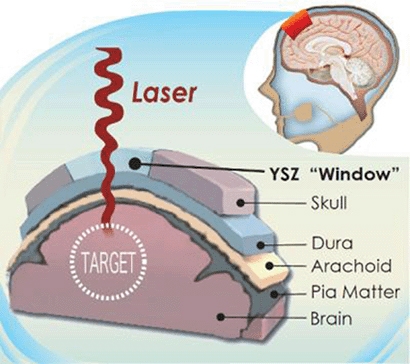The University of California, Riverside team’s implant is made from yttria-stabilised zirconia (YSZ), the same ceramic material currently used in hip implants and dental crowns that has been processed in a way to make it transparent.
Since YSZ has already proven itself to be well-tolerated by the body in other applications, the team’s advance now allows use of YSZ as a permanent window through which doctors can aim laser-based treatments for the brain, importantly, without having to perform repeated craniectomies, which involve removing a portion of the skull to access the brain.
‘This is a case of a science fiction sounding idea becoming science fact, with strong potential for positive impact on patients,’ said Guillermo Aguilar, a professor of mechanical engineering at UC Riverside’s Bourns College of Engineering (BCOE).
Aguilar is part of a team of 10 comprised of faculty, graduate students and researchers from UC Riverside’s Bourns College of Engineering and School of Medicine, who recently published a paper ‘Transparent Nanocrystalline Yttria-Stabilized-Zirconia Calvarium Prosthesis’ about their findings Nanomedicine: Nanotechnology, Biology and Medicine.
Laser-based treatments have shown promise for many brain disorders but realisation of this promise has been constrained by the need for a craniectomy to access the brain, since most medical lasers are unable to penetrate the skull.
The transparent YSZ implants developed by the UC Riverside team address this issue by providing a permanently implanted view port through the skull.
‘This is a crucial first step towards an innovative new concept that would provide a clinically-viable means for optically accessing the brain, on-demand, over large areas, and on a chronically-recurring basis, without need for repeated craniectomies,’ said team member Dr. Devin Binder, a clinician and an associate professor of biomedical sciences at UC Riverside.

Although the team’s YSZ windows are not the first transparent skull implants to be reported, they are the first that could be conceivably used in humans.
According to the university, this is due to the inherent toughness of YSZ, which makes it far more resistant to shock and impact than the glass-based implants previously demonstrated by others.
This enhances safety and may also reduce patient self-consciousness, since the reduced vulnerability of the implant could minimise the need for conspicuous protective headgear.




Viking Link connects UK and Danish grids
These underwater links must, based on experience with gas pipelines, be vulnerable to sabotage by hostile powers. Excessive dependency on them could...